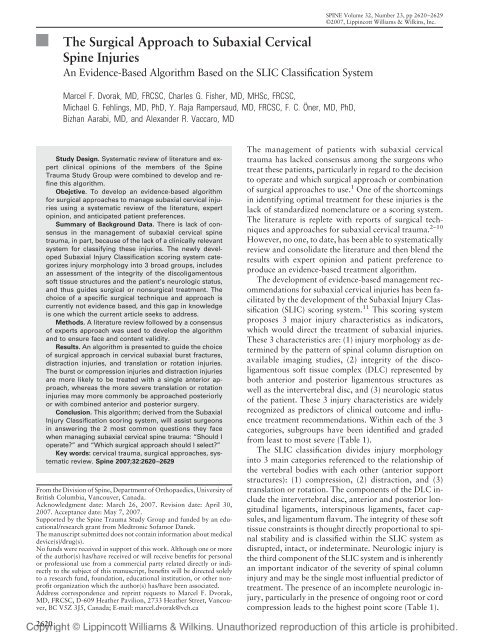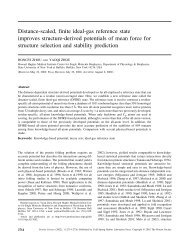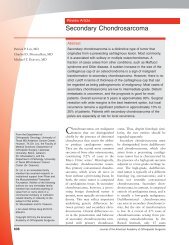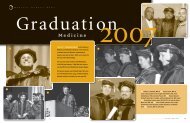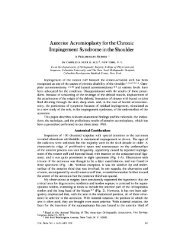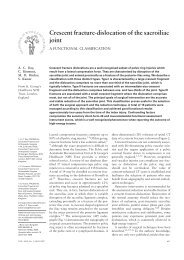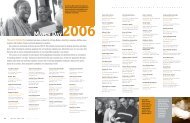The Surgical Approach to Subaxial Cervical Spine Injuries
The Surgical Approach to Subaxial Cervical Spine Injuries
The Surgical Approach to Subaxial Cervical Spine Injuries
Create successful ePaper yourself
Turn your PDF publications into a flip-book with our unique Google optimized e-Paper software.
<strong>The</strong> <strong>Surgical</strong> <strong>Approach</strong> <strong>to</strong> <strong>Subaxial</strong> <strong>Cervical</strong><br />
<strong>Spine</strong> <strong>Injuries</strong><br />
An Evidence-Based Algorithm Based on the SLIC Classification System<br />
Marcel F. Dvorak, MD, FRCSC, Charles G. Fisher, MD, MHSc, FRCSC,<br />
Michael G. Fehlings, MD, PhD, Y. Raja Rampersaud, MD, FRCSC, F. C. Öner, MD, PhD,<br />
Bizhan Aarabi, MD, and Alexander R. Vaccaro, MD<br />
SPINE Volume 32, Number 23, pp 2620–2629<br />
©2007, Lippincott Williams & Wilkins, Inc.<br />
Study Design. Systematic review of literature and expert<br />
clinical opinions of the members of the <strong>Spine</strong><br />
Trauma Study Group were combined <strong>to</strong> develop and refine<br />
this algorithm.<br />
Obejctive. To develop an evidence-based algorithm<br />
for surgical approaches <strong>to</strong> manage subaxial cervical injuries<br />
using a systematic review of the literature, expert<br />
opinion, and anticipated patient preferences.<br />
Summary of Background Data. <strong>The</strong>re is lack of consensus<br />
in the management of subaxial cervical spine<br />
trauma, in part, because of the lack of a clinically relevant<br />
system for classifying these injuries. <strong>The</strong> newly developed<br />
<strong>Subaxial</strong> Injury Classification scoring system categorizes<br />
injury morphology in<strong>to</strong> 3 broad groups, includes<br />
an assessment of the integrity of the discoligamen<strong>to</strong>us<br />
soft tissue structures and the patient’s neurologic status,<br />
and thus guides surgical or nonsurgical treatment. <strong>The</strong><br />
choice of a specific surgical technique and approach is<br />
currently not evidence based, and this gap in knowledge<br />
is one which the current article seeks <strong>to</strong> address.<br />
Methods. A literature review followed by a consensus<br />
of experts approach was used <strong>to</strong> develop the algorithm<br />
and <strong>to</strong> ensure face and content validity.<br />
Results. An algorithm is presented <strong>to</strong> guide the choice<br />
of surgical approach in cervical subaxial burst fractures,<br />
distraction injuries, and translation or rotation injuries.<br />
<strong>The</strong> burst or compression injuries and distraction injuries<br />
are more likely <strong>to</strong> be treated with a single anterior approach,<br />
whereas the more severe translation or rotation<br />
injuries may more commonly be approached posteriorly<br />
or with combined anterior and posterior surgery.<br />
Conclusion. This algorithm; derived from the <strong>Subaxial</strong><br />
Injury Classification scoring system, will assist surgeons<br />
in answering the 2 most common questions they face<br />
when managing subaxial cervical spine trauma: “Should I<br />
operate?” and “Which surgical approach should I select?”<br />
Key words: cervical trauma, surgical approaches, systematic<br />
review. <strong>Spine</strong> 2007;32:2620–2629<br />
From the Division of <strong>Spine</strong>, Department of Orthopaedics, University of<br />
British Columbia, Vancouver, Canada.<br />
Acknowledgment date: March 26, 2007. Revision date: April 30,<br />
2007. Acceptance date: May 7, 2007.<br />
Supported by the <strong>Spine</strong> Trauma Study Group and funded by an educational/research<br />
grant from Medtronic Sofamor Danek.<br />
<strong>The</strong> manuscript submitted does not contain information about medical<br />
device(s)/drug(s).<br />
No funds were received in support of this work. Although one or more<br />
of the author(s) has/have received or will receive benefits for personal<br />
or professional use from a commercial party related directly or indirectly<br />
<strong>to</strong> the subject of this manuscript, benefits will be directed solely<br />
<strong>to</strong> a research fund, foundation, educational institution, or other nonprofit<br />
organization which the author(s) has/have been associated.<br />
Address correspondence and reprint requests <strong>to</strong> Marcel F. Dvorak,<br />
MD, FRCSC, D-609 Heather Pavilion, 2733 Heather Street, Vancouver,<br />
BC V5Z 3J5, Canada; E-mail: marcel.dvorak@vch.ca<br />
<strong>The</strong> management of patients with subaxial cervical<br />
trauma has lacked consensus among the surgeons who<br />
treat these patients, particularly in regard <strong>to</strong> the decision<br />
<strong>to</strong> operate and which surgical approach or combination<br />
of surgical approaches <strong>to</strong> use. 1 One of the shortcomings<br />
in identifying optimal treatment for these injuries is the<br />
lack of standardized nomenclature or a scoring system.<br />
<strong>The</strong> literature is replete with reports of surgical techniques<br />
and approaches for subaxial cervical trauma. 2–10<br />
However, no one, <strong>to</strong> date, has been able <strong>to</strong> systematically<br />
review and consolidate the literature and then blend the<br />
results with expert opinion and patient preference <strong>to</strong><br />
produce an evidence-based treatment algorithm.<br />
<strong>The</strong> development of evidence-based management recommendations<br />
for subaxial cervical injuries has been facilitated<br />
by the development of the <strong>Subaxial</strong> Injury Classification<br />
(SLIC) scoring system. 11 This scoring system<br />
proposes 3 major injury characteristics as indica<strong>to</strong>rs,<br />
which would direct the treatment of subaxial injuries.<br />
<strong>The</strong>se 3 characteristics are: (1) injury morphology as determined<br />
by the pattern of spinal column disruption on<br />
available imaging studies, (2) integrity of the discoligamen<strong>to</strong>us<br />
soft tissue complex (DLC) represented by<br />
both anterior and posterior ligamen<strong>to</strong>us structures as<br />
well as the intervertebral disc, and (3) neurologic status<br />
of the patient. <strong>The</strong>se 3 injury characteristics are widely<br />
recognized as predic<strong>to</strong>rs of clinical outcome and influence<br />
treatment recommendations. Within each of the 3<br />
categories, subgroups have been identified and graded<br />
from least <strong>to</strong> most severe (Table 1).<br />
<strong>The</strong> SLIC classification divides injury morphology<br />
in<strong>to</strong> 3 main categories referenced <strong>to</strong> the relationship of<br />
the vertebral bodies with each other (anterior support<br />
structures): (1) compression, (2) distraction, and (3)<br />
translation or rotation. <strong>The</strong> components of the DLC include<br />
the intervertebral disc, anterior and posterior longitudinal<br />
ligaments, interspinous ligaments, facet capsules,<br />
and ligamentum flavum. <strong>The</strong> integrity of these soft<br />
tissue constraints is thought directly proportional <strong>to</strong> spinal<br />
stability and is classified within the SLIC system as<br />
disrupted, intact, or indeterminate. Neurologic injury is<br />
the third component of the SLIC system and is inherently<br />
an important indica<strong>to</strong>r of the severity of spinal column<br />
injury and may be the single most influential predic<strong>to</strong>r of<br />
treatment. <strong>The</strong> presence of an incomplete neurologic injury,<br />
particularly in the presence of ongoing root or cord<br />
compression leads <strong>to</strong> the highest point score (Table 1).<br />
2620
<strong>Subaxial</strong> <strong>Cervical</strong> <strong>Spine</strong> <strong>Injuries</strong> • Dvorak et al<br />
2621<br />
Table 1. <strong>Subaxial</strong> Injury Classification (SLIC) Scale<br />
Points<br />
Morphology<br />
No abnormality 0<br />
Compression burst 11 2<br />
Distraction (e.g., facet perch, hyperextension) 3<br />
Rotation or translation (e.g., facet dislocation,<br />
4<br />
unstable teardrop or advanced staged<br />
flexion compression injury)<br />
Discoligamen<strong>to</strong>us complex<br />
Intact 0<br />
Indeterminate (e.g., isolated interspinous<br />
1<br />
widening, MRI signal change only)<br />
Disrupted (e.g., widening of anterior disk<br />
2<br />
space, facet perch or dislocation)<br />
Neurological status<br />
Intact 0<br />
Root injury 1<br />
Complete cord injury 2<br />
Incomplete cord injury 3<br />
Continuous cord compression (neuro modifier<br />
1<br />
in the setting of a neurologic deficit)<br />
<strong>The</strong> SLIC scoring system can be used <strong>to</strong> direct treatment<br />
in<strong>to</strong> the broad categories of either surgical or nonsurgical<br />
by summing the points in each of the 3 categories outlined<br />
in Table 1. <strong>Injuries</strong> which score 5 or more points on SLIC<br />
are all treated surgically, whereas those scoring 3 or less are<br />
treated nonsurgically. A score of 4 is considered equivocal.<br />
Once the SLIC scoring system suggests that a specific injury<br />
should be treated surgically, the surgeon must decide which<br />
single or combination of surgical approaches <strong>to</strong> use. Although<br />
the SLIC classification guides the physician <strong>to</strong> either<br />
operative or nonoperative treatment, it does not assist in<br />
the choice of surgical approach. Currently, there is no evidence-based<br />
algorithm that would provide surgical treatment<br />
options and specify which approach should be used.<br />
This article focuses on the choice of surgical approach once<br />
the decision <strong>to</strong> operate has already been made.<br />
Evidence-based medicine is simply not just the best available<br />
systematic research, but must also integrate clinical<br />
expertise and the growing realm of patient preference. A<br />
systematic review is an exhaustive objective review of the pertinent<br />
literature around an a priori research question and is<br />
recognized as the optimal design for literature review.<br />
Clinical experts can use their experience and knowledge<br />
<strong>to</strong> strengthen and optimize research-generated guidelines.<br />
<strong>The</strong> <strong>Spine</strong> Trauma Study Group (STSG) is such a group of<br />
experts. It is composed of 48 spine surgeons (neurosurgical<br />
and orthopaedic) who have committed a substantial portion<br />
of their clinical practices and research <strong>to</strong> the provision<br />
of care <strong>to</strong> spine trauma patients. Finally, and increasingly<br />
more importantly, surgeons are relying on patient preference<br />
<strong>to</strong> guide management recommendations and decisions.<br />
Patient acceptance of devices such as the halothoracic-vest<br />
are an example of this. 12 Patients have been<br />
empowered in the treatment decision armed with information<br />
around probabilities of outcome, health-related quality<br />
of life, complications, and care paths.<br />
Although there is a limited amount of published literature<br />
that recommends specific surgical approaches for<br />
certain injuries, the published articles <strong>to</strong> date each have 1<br />
or more significant limitations: exclusive reliance on local<br />
experience; lack of consideration of the global experience<br />
in the literature; and failure <strong>to</strong> use well-described<br />
nomenclature <strong>to</strong> define the study population.<br />
<strong>The</strong>re were 2 principle objectives of the present study:<br />
(1) <strong>to</strong> undertake a qualitative systematic review of the<br />
literature on surgical treatment approaches for various<br />
subaxial cervical spine injuries; and (2) <strong>to</strong> integrate this<br />
literature review with the consensus opinion of experts<br />
from the STSG and the SLIC scoring system <strong>to</strong> propose<br />
an evidence-based algorithm <strong>to</strong> manage these injuries.<br />
This algorithm would be based on the 3 principal morphologic<br />
categories, while incorporating the other 2 interrelated<br />
SLIC categories, namely, neurology and discoligamen<strong>to</strong>us<br />
complex integrity. By building on the<br />
foundation of the SLIC scoring system and by adding an<br />
evidence-based treatment algorithm which specifically<br />
addresses the optimal surgical approach for subaxial cervical<br />
injuries, we intend <strong>to</strong> improve patient outcomes<br />
and facilitate education and clinical research.<br />
Methods<br />
Systematic Review<br />
For a given question, it is generally accepted that when homogeneous<br />
level 1 studies are not available, quantitative systematic<br />
review or meta-analysis cannot be done and a qualitative<br />
systematic review becomes the design of choice. This particular<br />
study lends itself well <strong>to</strong> a qualitative review as we are able <strong>to</strong><br />
apply the various levels of evidence <strong>to</strong> our broader question<br />
around appropriate surgical approaches. <strong>The</strong>refore, we categorized<br />
these studies according <strong>to</strong> their level of evidence and their<br />
appropriateness <strong>to</strong> the research question.<br />
Unique <strong>to</strong> this qualitative review is the inclusion of biomechanical<br />
studies that are particularly relevant <strong>to</strong> the question<br />
being asked.<br />
Inclusion or Exclusion Criteria. <strong>The</strong> criteria used <strong>to</strong> include<br />
studies in this review were determined a priori and considered the<br />
following fac<strong>to</strong>rs: (1) the population that was studied in the article;<br />
(2) the intervention that was being reported on; and (3) the<br />
outcome measures that were reported in the article. To be included<br />
in this literature review the study had <strong>to</strong> have adult patients<br />
(age 16 years) with subaxial cervical traumatic injuries from C3<br />
<strong>to</strong> T1 inclusive treated surgically with anterior, posterior, or combined<br />
anterior and posterior surgical approaches. <strong>The</strong> study had<br />
<strong>to</strong> measure the radiographic and/or clinical success of the treatment<br />
using validated outcome measures and/or radiographic measures<br />
and must have described the surgical approach used.<br />
<strong>The</strong> most common reasons for exclusion of what appeared<br />
<strong>to</strong> be appropriate studies were; failure <strong>to</strong> specify the surgical<br />
approach used in treating a cohort of patients, the use of outdated<br />
surgical techniques, which are no longer used or relevant<br />
(Cloward Procedure in cervical trauma, sublaminar wires,<br />
etc.), failure <strong>to</strong> adequately describe the injury patterns treated,<br />
and the inclusion of a heterogeneous population, i.e., nontraumatic<br />
conditions or injuries beyond the subaxial cervical spine.<br />
Literature Review. A comprehensive literature search was performed<br />
<strong>to</strong> identify potential studies including any article with an
2622 <strong>Spine</strong> • Volume 32 • Number 23 • 2007<br />
English language abstract. Electronic database searches of<br />
MEDLINE (1966 <strong>to</strong> November 2006) and EMBASE (1980 <strong>to</strong><br />
November 2006) were performed using both medical subject<br />
headings and text word searching. Terms used included fracture,<br />
cervical, spine fractures, fracture fixation—internal, cervical vertebra.<br />
A search of the electronic database of CINAHL (1982 <strong>to</strong><br />
November 2006) was conducted using the same text word search.<br />
Both the Database of Abstracts of Reviews of Effects and the<br />
Cochrane Database of Systematic Reviews were searched using<br />
text words. Reference lists from relevant articles were hand<br />
searched for additional citations. Content experts from the STSG<br />
were sought and questioned as <strong>to</strong> possible additional references.<br />
Study Selection. Two reviewers, both experienced spine surgeons,<br />
one with advanced epidemiology training, used a standardized<br />
process <strong>to</strong> evaluate the eligibility of each article. Articles<br />
were excluded based on abstract review; otherwise, all the<br />
remaining studies were assessed using the complete articles.<br />
Any disagreements between the 2 reviewers were resolved using<br />
a consensus approach.<br />
A qualitative synthesis of the published literature was performed<br />
and the conclusions drawn from this literature were used<br />
<strong>to</strong> construct the surgical approaches algorithm. <strong>The</strong> proposed algorithm,<br />
including a draft of this article, was then presented <strong>to</strong> the<br />
membership of the STSG by email for their opinion on the content<br />
and face validity of the new evidence-based treatment options. All<br />
members of the STSG were asked if they agree with the surgical<br />
approaches recommended by this algorithm and were in agreement<br />
with the content of the article or if they had major disagreements<br />
with the algorithm or the article. STSG members were further<br />
invited <strong>to</strong> propose changes <strong>to</strong> the article. After the email<br />
feedback, the algorithm was presented <strong>to</strong> the STSG members at<br />
the STSG semiannual meeting along with several representative<br />
radiographs and cases. <strong>The</strong>y were discussed <strong>to</strong> assess the face<br />
validity, whether the algorithm looks valid and seems reasonable,<br />
by the STSG members of this algorithm. <strong>The</strong> consensus of the<br />
majority of members of the STSG was obtained and none of the<br />
members had disagreements with the algorithm although significant<br />
input regarding the methodology was obtained.<br />
Results<br />
In the literature search that was performed in November<br />
2006, we identified 665 articles of potential relevance. <strong>The</strong><br />
study selection process eliminated 526 articles by a review<br />
of the abstracts alone. An additional 113 articles were excluded<br />
after a review of their methodology and results sections.<br />
Most of these were excluded because of relevance<br />
and methodologic issues. This left a <strong>to</strong>tal of 26 articles that<br />
met all inclusion criteria. Of these 26 articles, 1 article presented<br />
level I evidence based on its methodology and primary<br />
question. 13 <strong>The</strong>re were 3 level II articles 14–16 and 7<br />
level III articles, 12,17–22 which are presented in Table 2. A<br />
further 15 articles 2–10,23–28 were considered as level IV evidence<br />
relevant <strong>to</strong> the question of surgical approach for<br />
Table 2. <strong>Subaxial</strong> <strong>Cervical</strong> Trauma: <strong>Surgical</strong> <strong>Approach</strong>es<br />
Paper Author<br />
Description<br />
Level of Evidence of<br />
Primary Question<br />
Topic and Conclusions<br />
Kwon et al 13<br />
Brodke et al 14<br />
Do et al 15<br />
Ianuzzi et al 16<br />
Prospective randomized trial of anterior<br />
vs. posterior surgery for unilateral<br />
facet fractures, appropriately<br />
powered<br />
Prospective randomized (by day of<br />
admission). Trial of anterior vs.<br />
posterior surgical approach, not<br />
appropriately powered<br />
Biomechanics study comparing anterior<br />
and posterior fixation<br />
Biomechanics study comparing anterior<br />
and posterior fixation<br />
I<br />
II<br />
II<br />
II<br />
42 patients randomized <strong>to</strong> anterior or posterior fusion for facet<br />
fracture without spinal cord injury, no significant difference<br />
in time <strong>to</strong> discharge but differences in secondary outcomes<br />
52 patients with spinal cord injury assigned <strong>to</strong> anterior or<br />
posterior surgery with no difference between groups<br />
Biomechanical comparison of modern anterior/posterior/and<br />
combined fixation in flexion distraction and corpec<strong>to</strong>my<br />
models; anterior plating was inferior <strong>to</strong> posterior<br />
Biomechanical study comparing anterior and posterior fixation<br />
following three column injury; all fixation constructs were<br />
stiffer than the intact spinal segment<br />
Beyer et al 12 Retrospective comparative study III 36 patients with unilateral facet injuries treated non-operatively<br />
and operatively; surgical treatment had better results<br />
Elgafy et al 17 Retrospective case-control study III 65 patients with cervical fracture dislocations treated with<br />
posterior fixation; radiographic failure correlated with<br />
ligamen<strong>to</strong>us bilateral facet subluxations and high degree of<br />
kyphosis at injury<br />
Fisher et al 18 Retrospective comparative study III 45 patients with teardrop fractures treated in halo and with<br />
corpec<strong>to</strong>my and anterior plate. Improved radiographic<br />
outcomes in the surgical group<br />
Hadley et al 19<br />
Qualitative systematic review of class<br />
III and IV studies<br />
III<br />
Guidelines for management of subaxial cervical injuries<br />
suggest that anterior and posterior fixations are both valid<br />
treatment options<br />
Johnson et al 20 Retrospective case-control study III 87 patients with facet injuries treated with anterior plating:<br />
radiographic failure tended <strong>to</strong> occur in patients with<br />
endplate fractures and facet fractures<br />
Lifeso and Colucci 21 Retrospective comparative study III 29 retrospective controls and 18 prospective patients<br />
suggesting anterior fusion has improved outcomes over<br />
posterior or nonsurgical<br />
Toh et al 22 Retrospective comparative study III 31 burst fractures and teardrop fractures treated anteriorly and<br />
posteriorly. Anterior fusion was preferred for spinal canal<br />
decompression
<strong>Subaxial</strong> <strong>Cervical</strong> <strong>Spine</strong> <strong>Injuries</strong> • Dvorak et al<br />
2623<br />
Figure 1. <strong>Surgical</strong> approaches<br />
algorithm for central cord injuries<br />
with cervical spondylosis.<br />
subaxial cervical trauma. One level IV study was a prospective<br />
cohort study, 3 whereas the remaining 14 were retrospective<br />
cohort studies. Two of the 7 level III studies were<br />
retrospective case-control studies, 17,20 1 was a qualitative<br />
review, 19 and the remaining 4 were retrospective comparative<br />
studies. 12,18,21,22<br />
A core group within the STSG after a thorough review<br />
of the early literature developed the algorithm. This algorithm<br />
was presented <strong>to</strong> the membership of the STSG,<br />
and comments regarding the face and content validity<br />
were solicited through email and at the semiannual meeting<br />
of the STSG.<br />
<strong>The</strong> 3 main morphologic categories of the SLIC are:<br />
(1) compression or burst, (2) distraction, and (3) translation<br />
or rotation. Within each of these 3 categories, the<br />
interrelated nature of the other 2 categories of SLIC,<br />
namely, DLC integrity and neurology, are evident. We<br />
chose <strong>to</strong> define the segments of the algorithm based on<br />
the 3 morphologic categories, however, the importance<br />
of the DLC and neurology remain evident in the body of<br />
each individual algorithm.<br />
Central Cord Syndrome in the Presence of<br />
<strong>Cervical</strong> Spondylosis<br />
A unique injury pattern that is encountered with greater<br />
frequency, given our aging population, is the patient with a<br />
spondylotic cervical spine that is injured in hyperextension,<br />
leading <strong>to</strong> an incomplete central cord injury (Figure 1). 29–34<br />
Although these injuries will score 0 for both morphology<br />
(no injury) and DLC (intact), they score 4 for neurology<br />
(incomplete injury 3; persistent cord compression 1).<br />
Although several authors have suggested that there may be<br />
some benefit <strong>to</strong> early surgical decompression, 35,36 there are<br />
proponents of initial nonsurgical treatment as long as the<br />
spine is stable and neurology is static or improving. Specified<br />
re-evaluation is essential and may dictate delayed or<br />
late decompression. 29,37–39<br />
When surgery is indicated after central cord injury in the<br />
stable spondylotic spine, it is the overall cervical spinal<br />
alignment and the number of levels affected that determine<br />
the surgical approach. 30 When the spine is lordotic, and<br />
particularly when there are multiple levels of compression;<br />
a posterior approach, either a laminec<strong>to</strong>my and fusion or a<br />
cervical laminoplasty are recommended approaches. 28 If<br />
the spine is neutral or slightly kyphotic, then occasionally,<br />
after a posterior laminec<strong>to</strong>my, lordosis may be achieved<br />
with intraoperative positioning and maintained with posterior<br />
lateral mass fixation and fusion.<br />
When the spine is focally kyphotic, particularly when<br />
there is a fixed kyphosis, or in the presence of anterior<br />
compression from a disc protrusion or spondylotic bar at<br />
1 or 2 segments, an anterior surgical decompression (vertebrec<strong>to</strong>my<br />
or multiple discec<strong>to</strong>mies) is indicated. 19 Fusion<br />
and stabilization by means of an anterior strut and<br />
plate is also supported. 27<br />
Compression or Burst <strong>Injuries</strong><br />
<strong>Subaxial</strong> spine injuries where the primary injury is an<br />
axial load can cause either end-plate compression or<br />
burst fractures without disruption of the discoligamen<strong>to</strong>us<br />
complex (Figure 2). <strong>The</strong>se injuries are likely <strong>to</strong> score<br />
Figure 2. <strong>Surgical</strong> approaches algorithm for compression burst<br />
injuries.
2624 <strong>Spine</strong> • Volume 32 • Number 23 • 2007<br />
bony fusion. 7,8,14,16,18,27 Rarely is concomitant posterior<br />
stabilization necessary.<br />
Both dynamic and static locked cervical plates have<br />
been described 40,41 with generally theoretical advantages<br />
for each which leave the decision of which specific<br />
device <strong>to</strong> use up <strong>to</strong> the surgeon.<br />
Distraction <strong>Injuries</strong><br />
Distraction injuries occur in 2 general patterns; hyperextension,<br />
often occurring in the stiff spondylotic spine and<br />
hyperflexion leading <strong>to</strong> facet subluxations or perched<br />
facets (Figures 3 and 4).<br />
Figure 3. <strong>Surgical</strong> approaches algorithm for hyperextension injuries.<br />
1 or 2 on the morphology section of SLIC and 0 for DLC<br />
given that the posterior ligaments are intact. <strong>The</strong> neurology<br />
and the presence of residual compression of the spinal<br />
cord are therefore the strongest determinants of<br />
treatment. With complete or incomplete neurologic injury<br />
the SLIC system will add 2, 3, or 4 points <strong>to</strong> the 2<br />
morphology points leading <strong>to</strong> a score of 4 <strong>to</strong> 6, and thus<br />
favoring surgery with scores of 5 or greater.<br />
A number of authors 2,7,14,22,27 have reported on the<br />
efficacy of anterior decompression and fusion for subaxial<br />
cervical burst fractures. Although many of the<br />
above reports include a variety of fracture patterns, it is<br />
clear that for burst-type fractures, where bone is retropulsed<br />
in<strong>to</strong> the spinal canal causing neurologic injury,<br />
the anterior vertebral body resection and stabilization<br />
provides mechanical reconstitution of the motion segment,<br />
16 optimal decompression of the neural elements, 22<br />
and ample local au<strong>to</strong>genous bone graft from the resected<br />
vertebral body. In the presence of intact posterior elements,<br />
the use of an anterior locking plate and strut graft<br />
provides adequate stability <strong>to</strong> facilitate long-term stable<br />
Hyperextension Injury Avulsion Fractures. Classically,<br />
hyperextension injuries occur in elderly individuals<br />
with spondylotic or stiff spines (Figure 3). Anterior retropharyngeal<br />
soft tissue swelling, widening of the disc<br />
space, high fluid signal in an otherwise degenerative disc<br />
space along with avulsion fractures of anterior osteophytes,<br />
or the anteroinferior corner of a vertebral body<br />
all point <strong>to</strong> this pattern of injury. Assessing this injury in<br />
terms of its morphology and DLC status, these injuries<br />
score 3 for morphology and 2 for DLC with the addition<br />
of any score resulting from neurologic impairment. <strong>The</strong><br />
vast majority of these injuries require surgical stabilization.<br />
<strong>The</strong> surgical approach is informed by the pattern of<br />
DLC disruption (primarily anterior), and thus most commonly<br />
an anterior cervical discec<strong>to</strong>my fusion and plating<br />
is performed. 2,8,27 This injury seems <strong>to</strong> occur most commonly<br />
in the elderly where the spine is spondylotic. If the<br />
spondylosis is severe or in the case of DISH or ankylosing<br />
spondylitis, the stiffness of adjacent segments creates<br />
long lever arms that may best be neutralized with the<br />
addition of posterior fixation. 24<br />
Unilateral or Bilateral Facet Subluxation. Distraction injuries<br />
affecting primarily the posterior elements create a<br />
Figure 4. <strong>Surgical</strong> approaches<br />
algorithm for facet subluxations<br />
or perched facets.
<strong>Subaxial</strong> <strong>Cervical</strong> <strong>Spine</strong> <strong>Injuries</strong> • Dvorak et al<br />
2625<br />
spectrum of injury from a simple unilateral facet subluxation<br />
<strong>to</strong> bilateral perched facets. In each case, there is a<br />
varying degree of disruption of not only the posterior<br />
element ligamen<strong>to</strong>us structures but also the posterior<br />
anulus of the disc. <strong>The</strong>se injuries are no longer distraction<br />
and become translational injuries if the facet subluxation<br />
or perch progresses <strong>to</strong> a dislocation or becomes<br />
associated with a fracture. Magnetic resonance imaging<br />
(MRI) has been shown <strong>to</strong> be effective in evaluating the<br />
degree and type of soft tissue disruption associated with<br />
these injuries. 42–45<br />
<strong>The</strong> role of closed reduction and traction before definitive<br />
surgical stabilization remains controversial. Regardless<br />
of whether or not a closed reduction is attempted<br />
the decision as <strong>to</strong> which surgical approach <strong>to</strong><br />
choose rests on a number of fac<strong>to</strong>rs.<br />
When an MRI shows a fragment of disc material displaced<br />
dorsal <strong>to</strong> the posterior cortex of the more caudal<br />
vertebral body, 46 then the surgeons preference should be<br />
for an anterior approach. 2,7,9,21 This is another example<br />
of the extent of the DLC disruption (anterior disc protrusion)<br />
informing the choice of surgical approach. Anterior<br />
discec<strong>to</strong>my can decompress the spinal canal directly<br />
and can then be followed by an anterior closed<br />
reduction of the facet subluxation (usually achieved by<br />
placing the patient in some degree of cervical extension<br />
and by removing any intraoperative traction), inserting<br />
an interbody graft, and an anterior cervical<br />
plate. 2,7,8,13,20,21 Ensuring tight, 100% apposition of the<br />
facets, a trapezoidal interbody graft, and con<strong>to</strong>uring of<br />
the plate in<strong>to</strong> lordosis will optimize the stability of this<br />
anterior approach for what is primarily a posterior ligamen<strong>to</strong>us<br />
injury. Although some biomechanical studies<br />
have identified the inferiority of anterior fixation when<br />
compared with posterior fixation in these injuries, most<br />
studies show that anterior fixation alone for these posterior<br />
injuries returns the spine <strong>to</strong> at least the stability of<br />
the intact motion segment and combined with clinical<br />
case series provide a compelling case for this treatment<br />
alternative. 16,41<br />
When the disc is essentially intact or merely disrupted<br />
without frank herniation, then the surgeon can make a<br />
choice either anterior or posterior fixation based on patient<br />
and surgeon preference. Variables that may influence<br />
this decision include the available equipment and<br />
the training and familiarity of the surgeon with each<br />
approach. From the patients’ perspective, anterior issues<br />
such as neck scar, the risk of temporary dysphagia or<br />
hoarse voice, and injury <strong>to</strong> visceral structures (esophagus)<br />
may be compared with the additional muscle dissection<br />
and local wound infection risk found with posterior<br />
approaches. When a pure ligamen<strong>to</strong>us unilateral or bilateral<br />
facet subluxation is treated posteriorly, the <strong>to</strong>rn<br />
ligamentum flavum and any intervening hema<strong>to</strong>ma or<br />
scar tissue should be resected (flavo<strong>to</strong>my) before compressing<br />
<strong>to</strong> reduce the posterior elements. 47<br />
Specific <strong>to</strong> bilateral facet subluxations, however, are<br />
the findings of a study by Elgafy et al, 17 wherein patients<br />
with bilateral facet subluxations (perched facets without<br />
fracture) were found <strong>to</strong> develop higher degrees of kyphosis<br />
after posterior instrumented fusion. <strong>The</strong>y, and other<br />
authors 6,21 postulated that the disruption of the disc that<br />
occurs with these distraction injuries leads <strong>to</strong> progressive<br />
disc space collapse, which the posterior fixation is not<br />
able <strong>to</strong> overcome, thus allowing the spinal segment <strong>to</strong><br />
drift in<strong>to</strong> kyphosis. This tendency of posterior fusions <strong>to</strong><br />
lead <strong>to</strong> kyphosis has been identified by Lifeso and<br />
Colucci, who recommended anterior plating for these<br />
injuries. 21 Fehlings et al identified 2 patients with significant<br />
kyphosis after posterior fixation. 6 <strong>The</strong> long-term<br />
clinical significance of segmental kyphosis remains <strong>to</strong> be<br />
seen.<br />
Translation or Rotation <strong>Injuries</strong><br />
Unilateral or Bilateral Facet Fracture Dislocation or Subluxation.<br />
Translation or rotation injuries score the highest<br />
number of points on the morphology scale (4 points)<br />
and almost always are associated with significant ligamen<strong>to</strong>us<br />
disruption (DLC 2) (Figure 5). Before adding<br />
the neurology score, these injuries already score 6 on the<br />
SLIC scale and are thus the most unstable of all cervical<br />
injuries. Although these injuries may consist of a variety of<br />
posterior element pathologies spanning the spectrum from<br />
fracture separation of the lateral mass 25,26 (with translation<br />
or rotation since an undisplaced lateral mass fracture falls<br />
within the compression morphology) through completely<br />
dislocated or locked facets. <strong>The</strong>re may be varying degrees of<br />
posterior element fracture and comminution of the spinous<br />
process, lamina, and lateral masses in association with<br />
burst, sagittal and/or coronal fractures of the vertebral<br />
body leading <strong>to</strong> the “so-called” teardrop fracture.<br />
7,8,16,18,22,27<br />
All of these injuries therefore exhibit translation of 1<br />
vertebra relative <strong>to</strong> an adjacent vertebra. This occurs as<br />
either pure translation (i.e., bilateral locked facets) or as<br />
a rotational translation around a single intact facet (i.e.,<br />
displaced unilateral facet fracture or dislocation). <strong>The</strong><br />
principal features that subcategorize and differentiate injuries<br />
within the translation or rotation group are the<br />
presence or absence of fractures affecting the vertebral<br />
body and the presence, severity, and location of residual<br />
compression of the neural elements.<br />
End-Plate Compression Fracture With Facet Fracture/<br />
Dislocation. <strong>The</strong> vertebral body fracture may simply be a<br />
superior end-plate compression fracture that is often difficult<br />
<strong>to</strong> see on plain radiographs because of the natural<br />
shape and slope of the superior endplate of the subaxial<br />
cervical vertebrae. Once a minimal end-plate compression<br />
fracture is seen in association with a facet fracture,<br />
subluxation, or dislocation, this in general is a contraindication<br />
<strong>to</strong> anterior alone surgical fixation. Johnson et al<br />
showed that fully two-thirds of patients with an endplate<br />
compression fracture who were fused with an anterior<br />
approach alone developed early mechanical failure
2626 <strong>Spine</strong> • Volume 32 • Number 23 • 2007<br />
Figure 5. <strong>Surgical</strong> approaches<br />
algorithm for translation rotation<br />
injuries.<br />
of their fusion. 20 <strong>The</strong> presence of an end-plate compression<br />
fracture in association with a rotationally or translationally<br />
unstable posterior element injury necessitates<br />
at least a posterior instrumented fusion. If significant<br />
ligamen<strong>to</strong>us disruption is identified on MRI, if there is<br />
severe comminution of the facet or lateral mass, or if the<br />
surgeon is concerned about progressive kyphosis, then a<br />
combined anterior and posterior fusion may be indicated.<br />
23<br />
Vertebral Burst Fracture or Dislocation (Teardrop<br />
Fracture). More significant anterior vertebral body fractures<br />
have been described as quadrangular fractures, 48<br />
teardrop fractures, and burst-fracture dislocations.<br />
2,16,18,22 <strong>The</strong>se injuries all have in common significant<br />
posterior element failure (a combination of ligament<br />
and facet capsule injury in association with varying<br />
degree of facet and lateral mass fracturing) in association<br />
with significant fracturing of the vertebral body either<br />
with large coronal and sagittal fracture lines or a comminuted<br />
burst-type fractures. <strong>The</strong> hallmark retrodisplacement<br />
of the posterior vertebral body cortex relative<br />
<strong>to</strong> the cephalad and caudal vertebrae demonstrates the<br />
high degree of discoligamen<strong>to</strong>us disruption associated<br />
with this injury and is often the source of residual spinal<br />
cord compression. Often associated with complete neurologic<br />
injury, decompression by means of anterior vertebral<br />
body resection may facilitate neurologic recovery within<br />
the zone of partial preservation (root recovery). 22<br />
<strong>The</strong> majority of these injuries require combined anterior<br />
and posterior fixation because of the severe degree of<br />
bony and ligamen<strong>to</strong>us disruption they exhibit. 22,23 Today,<br />
with improved anesthesia and improved anterior<br />
locking plates and posterior segmental fixation systems,<br />
2,3,5–8,16,18,22,27 a combined anterior and posterior<br />
procedure is not as daunting a task. Cybulski et al reviewed<br />
a number of patients who failed single approach<br />
posterior stabilization and required combined anterior<br />
and posterior stabilization. 23 Before the use of MRI, Cybulski<br />
et al identified vertebral body retrolisthesis, facet<br />
dislocation, and shear injury through the disc as indications<br />
for circumferential (360) fusion. Similarly, De Iure<br />
et al suggested that any fracture in which an ana<strong>to</strong>mic<br />
reduction could not be obtained or any traumatic spondylolisthesis<br />
were indications for 360° fusion. 49 Toh et al<br />
preferred anterior decompression and fusion for its ability<br />
<strong>to</strong> res<strong>to</strong>re the spinal canal diameter and decompress<br />
neural elements. 22 Within the framework of the SLIC,<br />
and for this morphologic pattern of injury, neurology<br />
dictates the need for anterior decompression whereas the<br />
DLC disruption is the motivation for the posterior and<br />
anterior fixation. In this severe fracture pattern, our rec-
<strong>Subaxial</strong> <strong>Cervical</strong> <strong>Spine</strong> <strong>Injuries</strong> • Dvorak et al<br />
2627<br />
ommendation is that a circumferential fusion be performed.<br />
Unilateral or Bilateral Facet Fracture Dislocations (No<br />
Vertebral Body Fracture). This injury category contains<br />
a variety of injuries from the bilateral facet dislocation<br />
(bilateral locked facets), through a unilateral facet dislocation,<br />
<strong>to</strong> a variety of facet, lateral mass, and posterior<br />
element fractures all with rotational or translational instability.<br />
<strong>The</strong>re is no consensus in the literature on the<br />
role and timing of closed reduction as opposed <strong>to</strong> obtaining<br />
MRI, or even proceeding <strong>to</strong> immediate surgical decompression<br />
in these injuries and this <strong>to</strong>pic is beyond the<br />
scope of the present article. However, when this controversy<br />
is resolved, the surgeon is still faced with the question<br />
of which approach <strong>to</strong> choose for surgical stabilization,<br />
since all of these injuries are treated surgically.<br />
If by means of a prereduction MRI or after neurologic<br />
deterioration during closed reduction, the surgeon becomes<br />
aware of a fragment of disc material displaced<br />
in<strong>to</strong> the spinal canal, then an anterior discec<strong>to</strong>my, open<br />
reduction, fusion, and plating becomes necessary. 2,7,9 In<br />
approximately half of the cases, a closed reduction will<br />
be successful in reducing the dislocation before surgery.<br />
50 In the majority of the others, an intraoperative<br />
reduction performed after the discec<strong>to</strong>my and decompression<br />
will achieve ana<strong>to</strong>mic reduction. 9,51 For those<br />
patients in whom an anterior discec<strong>to</strong>my and decompression<br />
have not been successful in reducing the dislocation,<br />
then a supplemental posterior open reduction<br />
should be performed. 52<br />
As is the case in the vast majority of these unilateral or<br />
bilateral facet fracture dislocations, if there is no evidence<br />
of a loose fragment of disc in the spinal canal, then<br />
the surgeon may choose either anterior or posterior fixation.<br />
<strong>The</strong> decision between anterior and posterior approach<br />
when both are viable treatment options is based<br />
on a number of fac<strong>to</strong>rs in addition <strong>to</strong> those fac<strong>to</strong>rs discussed<br />
above in the distraction section of this article.<br />
<strong>The</strong>re are several reports that compare anterior and<br />
posterior surgery for subaxial cervical trauma, 13,14,53<br />
only 1 of which has been formally published. Excellent<br />
results have been reported with both approaches; however,<br />
each approach has its own unique advantages. <strong>The</strong><br />
posterior approach is biomechanically more robust, particularly<br />
when used <strong>to</strong> stabilize primarily posterior injuries.<br />
15,16 <strong>The</strong> posterior approach is familiar <strong>to</strong> surgeons,<br />
has a high radiographic success rate, and enables direct<br />
open reduction of dislocated posterior elements and thus<br />
is favored by many. 3–6,10,25,26 <strong>The</strong>re have been concerns,<br />
however, regarding the rate of wound infection and the<br />
ability of posterior alone stabilization <strong>to</strong> neutralize the<br />
development of segmental kyphosis as the injured disc<br />
collapses and settles. 13,21,53<br />
<strong>The</strong> anterior approach is favored by some because the<br />
traumatized patient does not have <strong>to</strong> be positioned<br />
prone, disc herniations can be directly removed, thus<br />
decompressing the canal, and the high fusion rate and<br />
maintenance of segmental lordosis are attractive.<br />
2,7,9,13,21 <strong>The</strong> criticism of the anterior approach for<br />
cervical subaxial trauma originates from its biomechanical<br />
inferiority when compared with posterior fixation,<br />
although it is still stiffer than an intact spine segment.<br />
15,16 Other concerns are the complications of dysphagia,<br />
hoarse voice, and early radiographic failure<br />
when used in the presence of end-plate compression fractures<br />
and very comminuted or large facet fracture fragments.<br />
13,20 Although the guidelines described by Spec<strong>to</strong>r<br />
et al relate <strong>to</strong> the prediction of failure of nonsurgical<br />
treatment, likely a similar measurement of the size of the<br />
facet fracture fragment would also predict the success of<br />
stand-alone anterior discec<strong>to</strong>my and fusion for facet<br />
fracture dislocations. 54<br />
<strong>The</strong> Influence of the Discoligamen<strong>to</strong>us Complex<br />
<strong>The</strong>re are several morphologic categories for which the<br />
pattern and extent of DLC disruption is the critical fac<strong>to</strong>r<br />
in determining the surgical approach within this algorithm.<br />
<strong>The</strong> hyperextension or posterior ligament injuries<br />
are often best treated by an approach from the direction<br />
of maximal soft tissue disruption. <strong>The</strong> extent of disc disruption<br />
and potential displacement can also define the<br />
primary surgical approach in the case of facet dislocations<br />
as has been discussed above. <strong>The</strong> reliability and<br />
validity of diagnosing injuries <strong>to</strong> the DLC are currently<br />
undergoing prospective study.<br />
<strong>The</strong> Influence of Neurology<br />
In the majority of cases where there is a spinal cord injury,<br />
complete or incomplete, surgery will likely be performed.<br />
In many of these cases, effective decompression<br />
of the spinal canal is a primary goal of treatment, if not <strong>to</strong><br />
obtain distal recovery, then <strong>to</strong> achieve local root or segmental<br />
recovery. <strong>The</strong> neurology guides the approach in<br />
the case of the incomplete spinal cord injury without<br />
instability. Neurology also influences the surgical approach<br />
when there is cord compression from a vertebral<br />
body fracture, anterior traumatic disc protrusion, or a<br />
facet fragment causing foraminal root compression.<br />
Discussion<br />
Spinal injuries occur in an estimated 150,000 people per<br />
year in North America, 11,000 of which have concomitant<br />
spinal cord injuries (1 out of every 25,000 people<br />
annually). 19,55 <strong>The</strong> exponential increase in the technology<br />
available for surgical fixation in the subaxial spine<br />
has not been paralleled by the evolution of guidelines or<br />
evidence-based recommendations on when <strong>to</strong> use this<br />
technology. One of the obstructions <strong>to</strong> the development<br />
of evidence-based consensus guidelines has been the<br />
largely descriptive and nonstandardized classification of<br />
injuries <strong>to</strong> the subaxial cervical spine.<br />
<strong>The</strong> SLIC severity scale, based on 3 components of<br />
injury (morphology, neurology, and DLC disruption),<br />
which, by consensus, represent major and largely independent<br />
determinants of prognosis and management, is<br />
an attempt <strong>to</strong> characterize injuries based on injury mor-
2628 <strong>Spine</strong> • Volume 32 • Number 23 • 2007<br />
phology and clinical status. 11 By building an algorithm<br />
for surgical approach on the interrelated components of<br />
the SLIC system, we feel that some clarity can be added<br />
<strong>to</strong> not only what <strong>to</strong> call an injury, but also what reasonable<br />
treatment options are available.<br />
<strong>The</strong> authors acknowledge that there are many injury<br />
patterns that can be managed nonsurgically and the SLIC<br />
classification will identify these. Our algorithm commences<br />
when the decision <strong>to</strong> operate has been made. It is<br />
also acknowledged by the authors that individual patterns<br />
of injury and unique patient fac<strong>to</strong>rs may influence<br />
the choice of treatment <strong>to</strong> the point where it may appropriately<br />
deviate from the options outlined in this article.<br />
No single algorithm or treatment approach can be adhered<br />
<strong>to</strong> rigidly in all situations and this report is simply<br />
a guideline <strong>to</strong> assist in the decision-making process.<br />
We have proposed anterior decompression, fusion,<br />
and plating for most burst fractures with neurologic impairment.<br />
We have also outlined the 2 major surgical<br />
treatment options for the spondylotic cervical spine with<br />
a central cord injury and ongoing spinal cord compression.<br />
<strong>The</strong> majority of hyperextension injuries are treated<br />
with anterior fixation, which in the severely ankylosed<br />
spine (DISH or ankylosing spondylitis) should probably<br />
be supplemented with posterior fixation. <strong>The</strong>re are a<br />
very few posterior distraction injuries that have a concomitant<br />
disc herniation and require anterior discec<strong>to</strong>my,<br />
fusion, and plating. However, for the remaining<br />
majority of these facet subluxations, the surgeon is free<br />
(and supported by current literature) <strong>to</strong> choose either<br />
anterior or posterior stabilization.<br />
<strong>The</strong> most complex and unstable group of injuries are<br />
the translation or rotation injuries where surgical approach<br />
decisions are made based on the involvement of<br />
the vertebral body (teardrop or compression fractures)<br />
and the presence of a disc herniation. Although many of<br />
the compression and distraction injuries can be managed<br />
with anterior surgery alone, injuries in the translation or<br />
rotation category are more commonly treated with posterior<br />
and circumferential fusion. Many of the most unstable<br />
injuries, such as teardrop fractures (translation<br />
with a vertebral body fracture) or bilateral facet fracture<br />
dislocations in which either closed or anterior open reduction<br />
are not successful in achieving ana<strong>to</strong>mic reduction<br />
are best managed with a circumferential anterior<br />
and posterior fusion. Less severe injuries such as the unilateral<br />
facet fracture dislocation may be managed with<br />
either posterior or anterior approaches alone.<br />
In summary, we propose an algorithm for surgical<br />
approaches <strong>to</strong> the traumatized subaxial cervical spine,<br />
which is based on the morphologic categories of the SLIC<br />
classification system and severity scale. <strong>The</strong> evidencebased<br />
nature of this algorithm emanates from its derivation<br />
through an exhaustive systematic literature review,<br />
the consensus of experts, and suggested inclusion of patient<br />
preference based on informed probabilities from the<br />
literature. Although the face and content validity of this<br />
algorithm seems satisfac<strong>to</strong>ry, it requires more robust criterion<br />
related validity and generalizability evaluation before<br />
it can be widely implemented. This algorithm is not<br />
intended <strong>to</strong> be a stagnant paradigm. Further literature<br />
will certainly refine the fac<strong>to</strong>rs that lead <strong>to</strong> 1 approach as<br />
opposed <strong>to</strong> another and will be added over time <strong>to</strong><br />
strengthen the classification leading <strong>to</strong> improved patient<br />
care.<br />
Key Points<br />
● An algorithm is proposed <strong>to</strong> guide the choice of<br />
surgical approaches <strong>to</strong> the traumatized subaxial<br />
cervical spine using the categories of burst, distraction,<br />
and translation.<br />
● <strong>The</strong> algorithm is based on a systematic literature<br />
review, the consensus of experts, and patient preference.<br />
● Burst or compression injuries and distraction injuries<br />
are more likely <strong>to</strong> be treated with a single<br />
anterior approach.<br />
● Translation or rotation injuries may more commonly<br />
be approached posteriorly or with combined<br />
anterior and posterior surgery.<br />
References<br />
1. Glaser JA, Jaworski BA, Cuddy BG, et al. Variation in surgical opinion<br />
regarding management of selected cervical spine injuries. A preliminary<br />
study. <strong>Spine</strong> 1998;23:975–82.<br />
2. Aebi M, Zuber K, Marchesi D. Treatment of cervical spine injuries with<br />
anterior plating. Indications, techniques, and results. <strong>Spine</strong> 1991;16:S38–<br />
S45.<br />
3. Anderson PA, Henley MB, Grady MS, et al. Posterior cervical arthrodesis<br />
with AO reconstruction plates and bone graft. <strong>Spine</strong> 1991;16:S72–S79.<br />
4. Cooper PR, Cohen A, Rosiello A, et al. Posterior stabilization of cervical<br />
spine fractures and subluxations using plates and screws. Neurosurgery<br />
1988;23:300–6.<br />
5. Ebraheim NA, Rupp RE, Savolaine ER, et al. Posterior plating of the cervical<br />
spine. J Spinal Disord 1995;8:111–15.<br />
6. Fehlings MG, Cooper PR, Errico TJ. Posterior plates in the management of<br />
cervical instability: long-term results in 44 patients. J Neurosurg 1994;81:<br />
341–9.<br />
7. Goffin J, Plets C, Van den BR. Anterior cervical fusion and osteosynthetic<br />
stabilization according <strong>to</strong> Caspar: a prospective study of 41 patients with<br />
fractures and/or dislocations of the cervical spine. Neurosurgery 1989;25:<br />
865–71.<br />
8. Lambiris E, Zouboulis P, Tyllianakis M, et al. Anterior surgery for unstable<br />
lower cervical spine injuries. Clin Orthop Relat Res 2003;61–9.<br />
9. Razack N, Green BA, Levi AD. <strong>The</strong> management of traumatic cervical bilateral<br />
facet fracture-dislocations with unicortical anterior plates. J Spinal Disord<br />
2000;13:374–81.<br />
10. Shapiro S, Snyder W, Kaufman K, et al. Outcome of 51 cases of unilateral<br />
locked cervical facets: interspinous braided cable for lateral mass plate fusion<br />
compared with interspinous wire and facet wiring with iliac crest. J Neurosurg<br />
1999;91:19–24.<br />
11. Vaccaro AR, Hurlbert RJ, Fisher CG, et al. <strong>The</strong> sub-axial cervical spine<br />
injury classification system (SLIC): a novel approach <strong>to</strong> recognize the importance<br />
of morphology, neurology and integrity of the disco-ligamen<strong>to</strong>us complex.<br />
<strong>Spine</strong>. 2007;32:2365–74.<br />
12. Beyer CA, Cabanela ME, Berquist TH. Unilateral facet dislocations and<br />
fracture-dislocations of the cervical spine. J Bone Joint Surg Br 1991;73:<br />
977–81.<br />
13. Kwon BK, Boyd M, Fisher CG, et al. A prospective randomized controlled<br />
trial comparing anterior versus posterior stabiliztion for unilateral facet injuries<br />
of the cervical spine. Presented at: Abstracts of the 12th International<br />
Meeting on Advanced <strong>Spine</strong> Techniques (IMAST), Banff, Alberta, July 7,<br />
2005.<br />
14. Brodke DS, Anderson PA, Newell DW, et al. Comparison of anterior and
<strong>Subaxial</strong> <strong>Cervical</strong> <strong>Spine</strong> <strong>Injuries</strong> • Dvorak et al<br />
2629<br />
posterior approaches in cervical spinal cord injuries. J Spinal Disord Tech<br />
2003;16:229–35.<br />
15. Do KY, Lim TH, Won YJ, et al. A biomechanical comparison of modern<br />
anterior and posterior plate fixation of the cervical spine. <strong>Spine</strong> 2001;26:<br />
15–21.<br />
16. Ianuzzi A, Zambrano I, Tataria J, et al. Biomechanical evaluation of surgical<br />
constructs for stabilization of cervical teardrop fractures. <strong>Spine</strong> J 2006;6:<br />
514–23.<br />
17. Elgafy H, Fisher CG, Zhao Y, et al. <strong>The</strong> radiographic failure of single segment<br />
posterior cervical instrumentation in traumatic cervical flexion distraction<br />
injuries. Top Spinal Cord Inj Rehabil 2006;12:20–9.<br />
18. Fisher CG, Dvorak MF, Leith J, et al. Comparison of outcomes for unstable<br />
lower cervical flexion teardrop fractures managed with halo thoracic vest<br />
versus anterior corpec<strong>to</strong>my and plating. <strong>Spine</strong> 2002;27:160–6.<br />
19. Hadley MN, Walters BC, Grabb PA, et al. Guidelines for the management<br />
of acute cervical spine and spinal cord injuries. Clin Neurosurg 2002;49:<br />
407–98.<br />
20. Johnson MG, Fisher CG, Boyd M, et al. <strong>The</strong> radiographic failure of single<br />
segment anterior cervical plate fixation in traumatic cervical flexion distraction<br />
injuries. <strong>Spine</strong> 2004;29:2815–20.<br />
21. Lifeso RM, Colucci MA. Anterior fusion for rotationally unstable cervical<br />
spine fractures. <strong>Spine</strong> 2000;25:2028–34.<br />
22. Toh E, Nomura T, Watanabe M, et al. <strong>Surgical</strong> treatment for injuries of the<br />
middle and lower cervical spine. Int Orthop 2006;30:54–8.<br />
23. Cybulski GR, Douglas RA, Meyer PR Jr, et al. Complications in threecolumn<br />
cervical spine injuries requiring anterior-posterior stabilization.<br />
<strong>Spine</strong> 1992;17:253–6.<br />
24. Einsiedel T, Schmelz A, Arand M, et al. <strong>Injuries</strong> of the cervical spine in<br />
patients with ankylosing spondylitis: experience at two trauma centers.<br />
J Neurosurg <strong>Spine</strong> 2006;5:33–45.<br />
25. Kotani Y, Abumi K, I<strong>to</strong> M, et al. <strong>Cervical</strong> spine injuries associated with<br />
lateral mass and facet joint fractures: new classification and surgical treatment<br />
with pedicle screw fixation. Eur <strong>Spine</strong> J 2005;14:69–77.<br />
26. Levine AM, Mazel C, Roy-Camille R. Management of fracture separations<br />
of the articular mass using posterior cervical plating. <strong>Spine</strong> 1992;17:S447–<br />
S454.<br />
27. Ripa DR, Kowall MG, Meyer PR Jr, et al. Series of ninety-two traumatic<br />
cervical spine injuries stabilized with anterior ASIF plate fusion technique.<br />
<strong>Spine</strong> 1991;16:S46–S55.<br />
28. Uribe J, Green BA, Vanni S, et al. Acute traumatic central cord syndrome–<br />
experience using surgical decompression with open-door expansile cervical<br />
laminoplasty. Surg Neurol 2005;63:505–10.<br />
29. Dvorak MF, Fisher CG, Hoekema J, et al. Fac<strong>to</strong>rs predicting mo<strong>to</strong>r recovery<br />
and functional outcome after traumatic central cord syndrome: a long-term<br />
follow-up. <strong>Spine</strong> 2005;30:2303–11.<br />
30. Harrop JS, Sharan A, Ratliff J. Central cord injury: pathophysiology, management,<br />
and outcomes. <strong>Spine</strong> J 2006;6:S198–S206.<br />
31. Tow AM, Kong KH. Central cord syndrome: functional outcome after rehabilitation.<br />
Spinal Cord 1998;36:156–60.<br />
32. Waters RL, Adkins RH, Sie IH, et al. Mo<strong>to</strong>r recovery following spinal cord<br />
injury associated with cervical spondylosis: a collaborative study. Spinal<br />
Cord 1996;34:711–15.<br />
33. Wilkinson HA. Central cord syndrome. J Neurosurg 2002;97:158–9.<br />
34. Yamazaki T, Yanaka K, Fujita K, et al. Traumatic central cord syndrome:<br />
analysis of fac<strong>to</strong>rs affecting the outcome. Surg Neurol 2005;63:95–9.<br />
35. Chen TY, Dickman CA, Eleraky M, et al. <strong>The</strong> role of decompression for<br />
acute incomplete cervical spinal cord injury in cervical spondylosis. <strong>Spine</strong><br />
1998;23:2398–403.<br />
36. Guest J, Eleraky MA, Apos<strong>to</strong>lides PJ, et al. Traumatic central cord syndrome:<br />
results of surgical management. J Neurosurg 2002;97:25–32.<br />
37. Ishida Y, Tominaga T. Predic<strong>to</strong>rs of neurologic recovery in acute central cervical<br />
cord injury with only upper extremity impairment. <strong>Spine</strong> 2002;27:1652–8.<br />
38. McKinley W, Meade MA, Kirshblum S, et al. Outcomes of early surgical<br />
management versus late or no surgical intervention after acute spinal cord<br />
injury. Arch Phys Med Rehabil 2004;85:1818–25.<br />
39. Pollard ME, Apple DF. Fac<strong>to</strong>rs associated with improved neurologic outcomes<br />
in patients with incomplete tetraplegia. <strong>Spine</strong> 2003;28:33–9.<br />
40. Brodke DS, Klimo P Jr, Bachus KN, et al. Anterior cervical fixation: analysis<br />
of load-sharing and stability with use of static and dynamic plates. J Bone<br />
Joint Surg Am 2006;88:1566–73.<br />
41. Dvorak MF, Pitzen T, Zhu Q, et al. Anterior cervical plate fixation: a biomechanical<br />
study <strong>to</strong> evaluate the effects of plate design, endplate preparation,<br />
and bone mineral density. <strong>Spine</strong> 2005;30:294–301.<br />
42. Geck MJ, Yoo S, Wang JC. Assessment of cervical ligamen<strong>to</strong>us injury in<br />
trauma patients using MRI. J Spinal Disord 2001;14:371–7.<br />
43. Halliday AL, Henderson BR, Hart BL, et al. <strong>The</strong> management of unilateral<br />
lateral mass/facet fractures of the subaxial cervical spine: the use of magnetic<br />
resonance imaging <strong>to</strong> predict instability. <strong>Spine</strong> 1997;22:2614–21.<br />
44. Klein GR, Vaccaro AR, Albert TJ, et al. Efficacy of magnetic resonance<br />
imaging in the evaluation of posterior cervical spine fractures. <strong>Spine</strong> 1999;<br />
24:771–4.<br />
45. Vaccaro AR, Madigan L, Schweitzer ME, et al. Magnetic resonance imaging<br />
analysis of soft tissue disruption after flexion-distraction injuries of the subaxial<br />
cervical spine. <strong>Spine</strong> 2001;26:1866–72.<br />
46. Vaccaro AR, Falatyn SP, Flanders AE, et al. Magnetic resonance evaluation<br />
of the intervertebral disc, spinal ligaments, and spinal cord before and after<br />
closed traction reduction of cervical spine dislocations. <strong>Spine</strong> 1999;24:<br />
1210–17.<br />
47. Ludwig SC, Vaccaro AR, Balders<strong>to</strong>n RA, et al. Immediate quadriparesis after<br />
manipulation for bilateral cervical facet subluxation. A case report. J Bone<br />
Joint Surg Am 1997;79:587–90.<br />
48. Favero KJ, Van Peteghem PK. <strong>The</strong> quadrangular fragment fracture. Roentgenographic<br />
features and treatment pro<strong>to</strong>col. Clin Orthop Relat Res 1989;<br />
239:40–6.<br />
49. De Iure F, Scimeca GB, Palmisani M, et al. Fractures and dislocations of the<br />
lower cervical spine: surgical treatment. A review of 83 cases. Chir Organi<br />
Mov 2003;88:397–410.<br />
50. Hadley MN, Fitzpatrick BC, Sonntag VK, et al. Facet fracture-dislocation<br />
injuries of the cervical spine. Neurosurgery 1992;30:661–6.<br />
51. Vital JM, Gille O, Senegas J, et al. Reduction technique for uni- and biarticular<br />
dislocations of the lower cervical spine. <strong>Spine</strong> 1998;23:949–54.<br />
52. Payer M. Immediate open anterior reduction and antero-posterior fixation/<br />
fusion for bilateral cervical locked facets. Acta Neurochir (Wien) 2005;147:<br />
509–13.<br />
53. Rober<strong>to</strong> RF, Porter S, Hart R. Is anterior stabilization of cervical fracture<br />
dislocations associated with higher complication rates than posterior stabilization?<br />
In: Abstracts of the 34th Annual Meeting of the <strong>Cervical</strong> <strong>Spine</strong><br />
Research Society. San Francisco, CA: <strong>Cervical</strong> <strong>Spine</strong> Research Society; December<br />
1, 2006: 40–1.<br />
54. Spec<strong>to</strong>r LR, Kim DH, Affonso J, et al. Use of computed <strong>to</strong>mography <strong>to</strong><br />
predict failure of nonoperative treatment of unilateral facet fractures of the<br />
cervical spine. <strong>Spine</strong> 2006;31:2827–35.<br />
55. Lowery DW, Wald MM, Browne BJ, et al. Epidemiology of cervical spine<br />
injury victims. Ann Emerg Med 2001;38:12–16.


